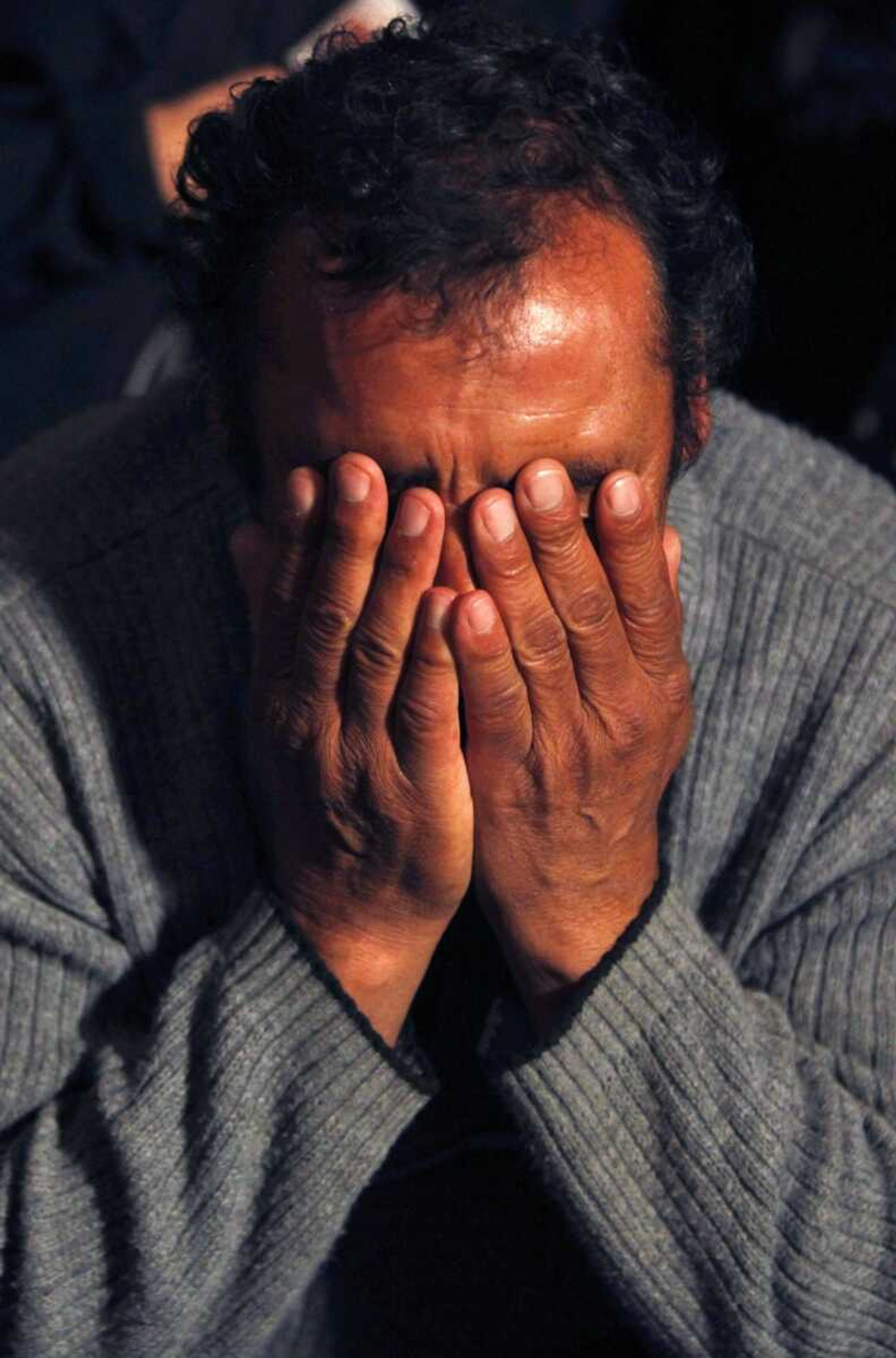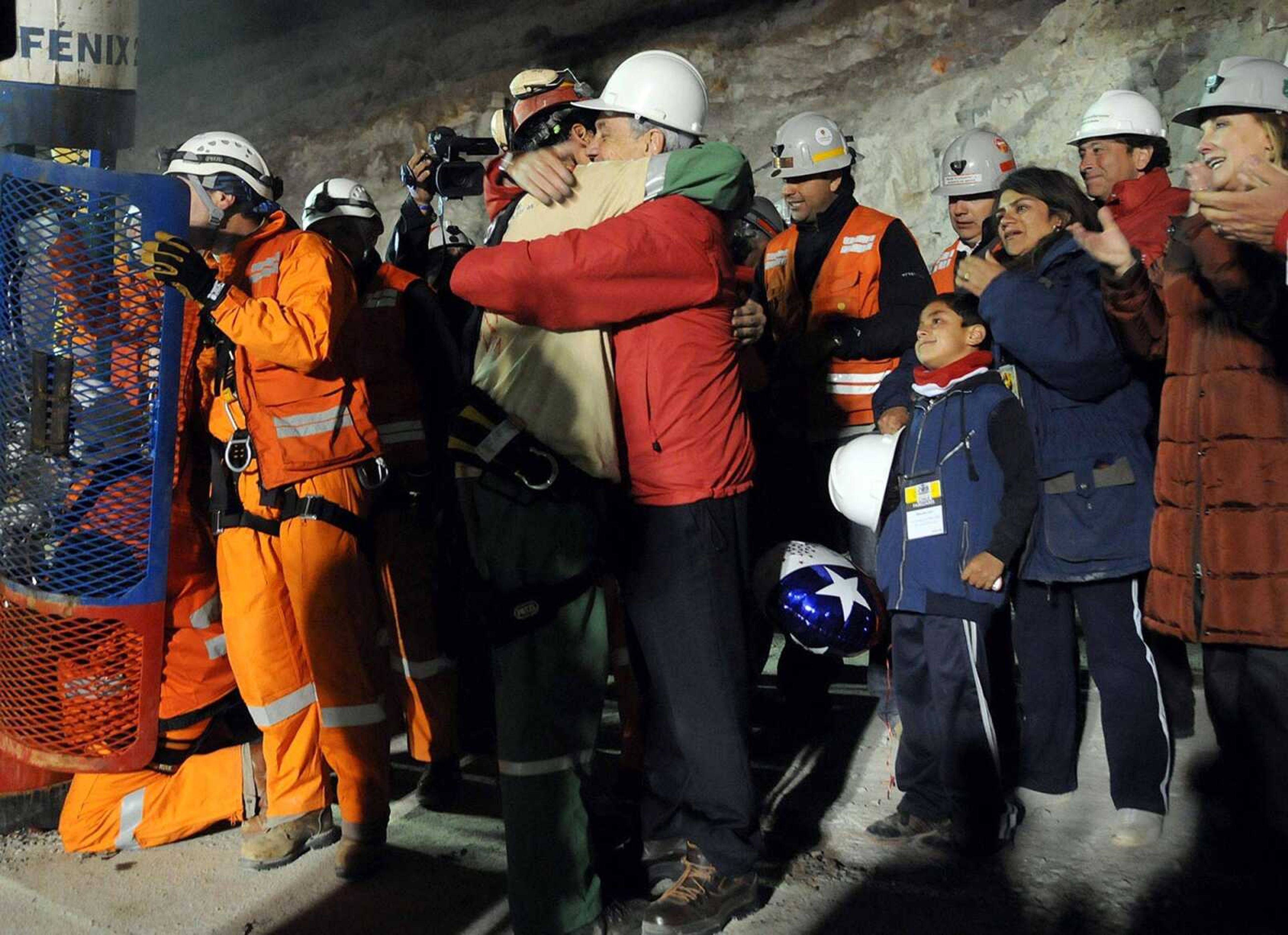First of 33 trapped miners rescued
SAN JOSE MINE, Chile -- Florencio Avalos, the first of 33 miners to be rescued, has surfaced after 69 days underground. He stepped out of a rescue capsule amid sobs from his young son and received a bracing bear hug from Chilean President Sebastian Pinera...
SAN JOSE MINE, Chile -- Florencio Avalos, the first of 33 miners to be rescued, has surfaced after 69 days underground.
He stepped out of a rescue capsule amid sobs from his young son and received a bracing bear hug from Chilean President Sebastian Pinera.
Avalos smiled widely as he hugged rescuers, then Pinera, as his wife, two sons and father looked on. His 7-year-old son Bairo sobbed, as did Chile's first lady, Cecilia Morel. Then Avalos was escorted into a medical triage center for the first of a battery of tests.
Earlier Tuesday night, a rescuer in a missile-like escape capsule was lowered down a nearly half-mile tunnel in the Chilean desert to bring the miners to fresh air and freedom after 69 days -- the longest anyone has ever been trapped underground and survived.
Mine rescue expert Manuel Gonzalez grinned and made the sign of the cross as he was lowered into the shaft. Pinera wished him good luck and urged him to bring the miners up in good shape.

A rescue expert with the state copper company Codelco, Gonzalez was followed by Roberto Ros, a paramedic with the Chilean navy's special forces. Together they will prepare the miners for their rescue -- expected to take as many as 36 hours for all to surface.
Rescue workers, the president and his ministers then sang the national anthem and chanted "Chi, Chi, Chi, Le, Le, Le" -- the country's name -- while horns honked and people cheered in the tent camp below.
In the family camp outside the mine, relatives of Avalos, the miner chosen to come up first, cheered, sang and prayed.
"We made a promise to never surrender, and we kept it," Pinera said earlier as he waited to greet the miners, whose endurance and unity captivated the world as Chile meticulously prepared their rescue.
Avalos, the 31-year-old second-in-command of the miners, has been so shy that he volunteered to handle the camera rescuers sent down so he wouldn't have to appear on the videos that the miners sent up.
The last miner out is also decided: Shift foreman Luis Urzua, whose leadership was credited for helping the men endure 17 days with no outside contact after the collapse. The men made 48 hours' worth of rations last before rescuers reached them with a narrow borehole to send down more food.
Janette Marin, sister-in-law of miner Dario Segovia, said the order of rescue didn't matter.
"What matters is that he is getting out, that they are all getting out," she said.
"This won't be a success unless they all get out," she added, echoing the solidarity that the miners and people across Chile have expressed.
The paramedics can change the order of rescue based on a brief medical check once they're in the mine. First out will be those best able to handle any difficulties and tell their comrades what to expect. Then, the weakest and the ill -- in this case, about 10 suffer from hypertension, diabetes, dental and respiratory infections and skin lesions from the mine's oppressive humidity. The last should be people who are both physically fit and strong of character.
Chile has taken extensive precautions to ensure the miners' privacy, using a screen to block the top of the shaft from the more than 1,000 journalists at the scene.
The miners will be ushered through an inflatable tunnel, like those used in sports stadiums, to an ambulance for a trip of several hundred yards to a triage station for a medical check. They will gather with a few relatives in an area also closed to the media, before being taken by helicopter to a hospital.
Each ride up the shaft is expected to take about 20 minutes, and authorities expect they can haul up one miner per hour. When the last man surfaces, it promises to end a national crisis that began when 700,000 tons of rock collapsed Aug. 5, sealing the miners into the lower reaches of the mine.
The only media allowed to record them coming out of the shaft will be a government photographer and Chile's state TV channel, whose live broadcast will be delayed by 30 seconds or more to prevent the release of anything unexpected. Photographers and camera operators are on a platform more than 300 feet (90 meters) away.
The worst technical problem that could happen, rescue coordinator Andre Sougarett told The Associated Press, is that "a rock could fall," potentially jamming the capsule partly up the shaft.
Panic attacks are the rescuers' biggest concern. The miners will not be sedated -- they need to be alert in case something goes wrong. If a miner must get out more quickly, rescuers will accelerate the capsule to a maximum 3 meters per second, Health Minister Jaime Manalich said.
The rescue attempt is risky simply because no one else has ever tried to extract miners from such depths, said Davitt McAteer, who directed the U.S. Mine Safety and Health Administration in the Clinton administration. A miner could get claustrophobic and do something to damage the capsule. Or a falling rock could wedge it in the shaft. Or the cable could get hung up. Or the rig that pulls the cable could overheat.
"You can be good and you can be lucky. And they've been good and lucky," McAteer told the AP. "Knock on wood that this luck holds out for the next 33 hours."
Golborne, whose management of the crisis has made him a media star in Chile, said authorities had already thought of everything.
"There is no need to try to start guessing what could go wrong. We have done that job," Golborne said. "We have hundreds of different contingencies."
As for the miners, Manalich said, "It remains a paradox -- they're actually much more relaxed than we are."
Rescuers finished reinforcing the top of the 2,041-foot (622-meter) escape shaft Monday, and the 13-foot (four-meter) capsule descended flawlessly in tests. The capsule -- the biggest of three built by Chilean navy engineers -- was named Phoenix I for the mythical bird that rises from ashes. It is painted in the white, blue and red of the Chilean flag.
The miners were to be closely monitored from the moment they're strapped in the capsule. They were given a high-calorie liquid diet donated by NASA, designed to keep them from vomiting as the rescue capsule rotates 10 to 12 times through curves in the 28-inch-diameter escape hole.
A small video camera is in the escape capsule, trained on each miner's face for panic attacks. The miners will wear oxygen masks and have two-way voice communication.
Their pulse, skin temperature and respiration rate will be constantly measured through a biomonitor around their abdomens. To prevent blood clotting from the quick ascent, they took aspirin and will wear compression socks.
The miners will also wear sweaters because they'll experience a shift in climate from about 90 degrees underground to near freezing on the surface after nightfall. Those coming out during daylight hours will wear sunglasses.
Engineers inserted steel piping at the top of the shaft, which is angled 11 degrees off vertical before plunging like a waterfall. Drillers had to curve the shaft to pass through "virgin" rock, narrowly avoiding collapsed areas and underground open spaces in the overexploited mine, which had operated since 1885.
Seconds before each miner surfaces, a siren will sound and a light will flash for a minute to alert doctors to an arriving miner.
After initial medical checks and visits with family members selected by the miners, the men will be flown to the hospital in Copiapo, a 10-minute ride away. Two floors have been prepared where the miners will receive physical and psychological exams and be kept under observation in a ward as dark as a movie theater.
Chilean air force Lt. Col. Aldo Carbone said helicopter pilots have night-vision goggles but won't fly unless it is clear of the thick Pacific Ocean fog that rolls in at night.
Families were urged to wait and prepare to greet the miners at home after a 48-hour hospital stay. Manalich said no cameras or interviews will be allowed until the miners are released, unless the miners expressly desire it.
Neighbors looked forward to barbecues and parties to replace the vigils held since their friends were trapped.
Urzua's neighbors told the AP that he probably insisted on being the last one up.
"He's a very good guy -- he keeps everybody's spirits up and is so responsible -- he's going to see this through to the end," said neighbor Angelica Vicencio, who has led a nightly vigil outside the Urzua home in Copiapo.
U.S. President Barack Obama praised rescuers, who include many Americans. "While that rescue is far from over and difficult work remains, we pray that by God's grace, the miners will be able to emerge safely and return to their families soon," he said.
Chile has promised that its care of the miners won't end for six months at least -- not until they can be sure that each miner has readjusted.
Psychiatrists and other experts in surviving extreme situations predict their lives will be anything but normal.
Since Aug. 22, when a narrow bore hole broke through to their refuge and the miners stunned the world with a note, scrawled in red pen, disclosing their survival, their families have been exposed in ways they never imagined. Miners had to describe their physical and mental health in minute detail with teams of doctors and psychologists. In some cases, when both wives and lovers claimed the same man, everyone involved had to face the consequences.
------
Associated Press writers Frank Bajak and Vivian Sequera contributed to this report.
Connect with the Southeast Missourian Newsroom:
For corrections to this story or other insights for the editor, click here. To submit a letter to the editor, click here. To learn about the Southeast Missourian’s AI Policy, click here.









